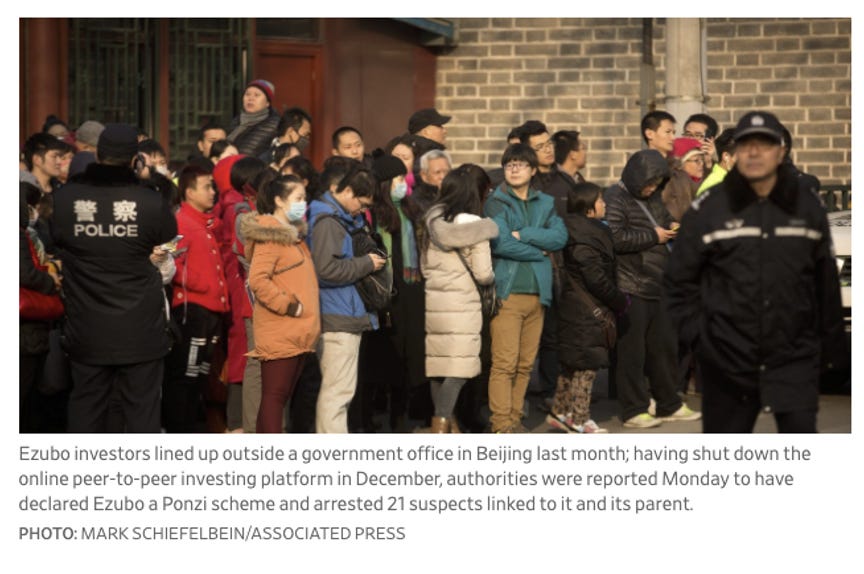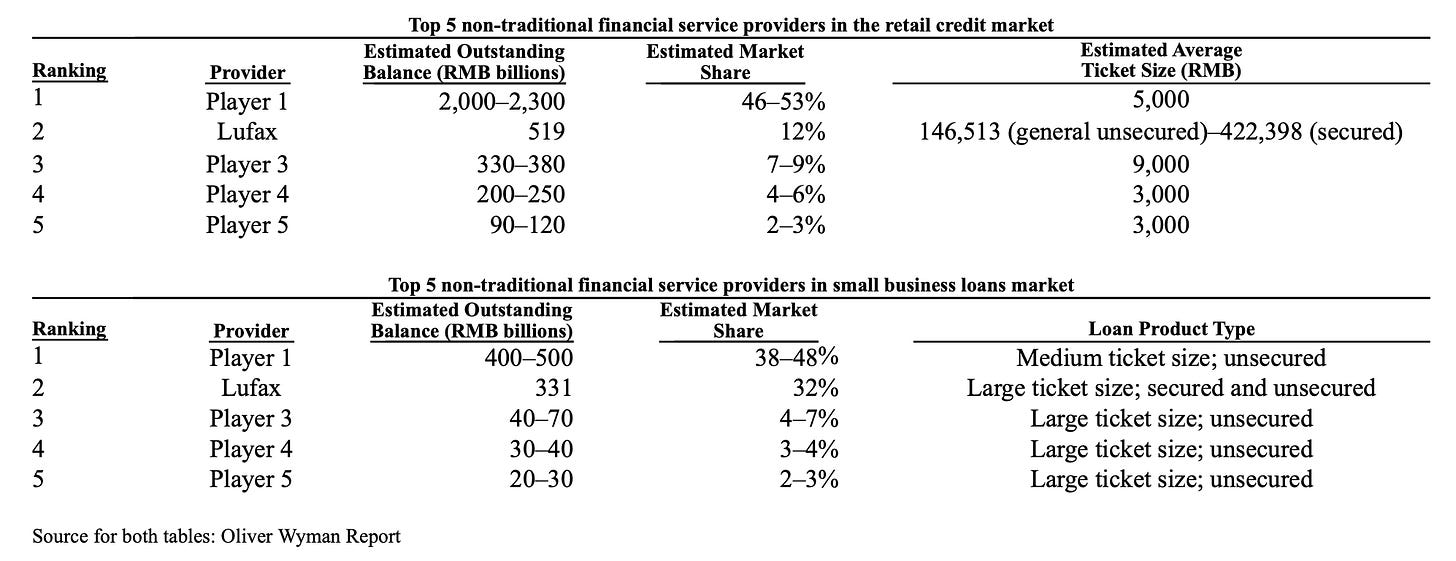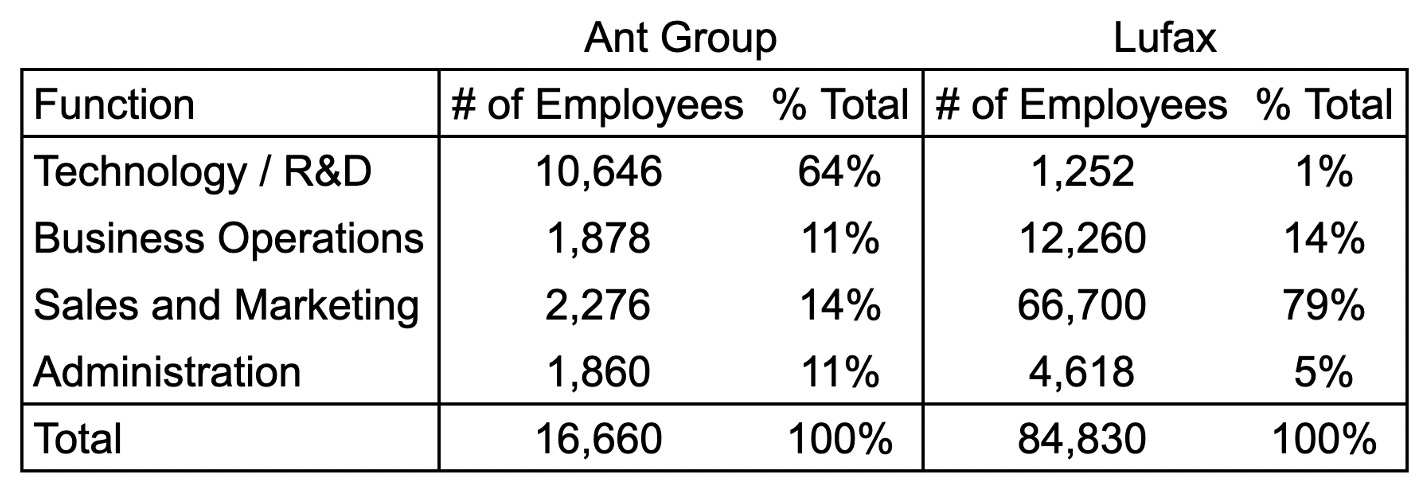
This post originally appeared on Substack as a part of my newsletter, East Meets West. Please subscribe there for now

Follow me on Twitter: @ryanrodenbaugh
Today’s Rundown:
The history of P2P lending in China is riddled with conflicting information, tough to understand regulations, and many pieces are still unfolding (as you will see in the news section!)
On October 29, 2020, Lufax, a Chinese online lender, raised $2.4 billion in one of 2020’s largest U.S. IPOs. The company is valued at $40 billion+.
The 13-years between the start of the peer-to-peer (P2P) lending industry in China and the Lufax IPO are a true rollercoaster.

Compiled #s from 6 sources
In 2006, China’s first peer-to-peer (p2p) lending company, CreditEase launched. This was on the back of the launch of Zopa in the UK in 2005 and LendingClub in the US in 2006.
In its purest form (and to oversimplify a bit), P2P lending is connecting people that have capital directly with people who need capital. While the connector will usually charge some fee, part of the promise is that you are still cutting out a more extractive middle man (often a bank).
China’s financial industry (circa ’05 – ’15) was particularly well-suited for P2P and micro-lending.
The P2P industry was willing to take on risk and provide credit to individuals and small businesses, while also offering high yield investment opportunities to China’s millions of savers.
I’ve read highly conflicting numbers, but near the peak in 2016/2017, there were somewhere between 4,000 – 7,000 P2P and micro-lending platforms operating in China, doing nearly 130 billion RMB ($19 billion) in volume per month.
There was a big opportunity to do something meaningful and expand the lending market in China to more individuals and small businesses. But the frenzy got the best of people. Like any good speculative bubble, the industry quickly attracted many fraudsters.
There were all kinds of things wrong with how the industry was being run in China. Corporate funds were co-mingled with funds that were supposed to be segregated for borrowers, returns were guaranteed by the companies, and companies were rarely acting as just a matchmaker or escrow agent of the client funds. Without any kind of standards, purely fraudulent entities were able to amass billions of dollars of customer funds.
The problems of the industry were best displayed by the industry’s leader in 2016, Ezubo.
The biggest blow-up happened in February 2016, when it was uncovered that Ezubo, which was the largest P2P lender in China at the time, was actually a giant Ponzi scheme.
At its height, Ezubo had raised RMB 59 billion (US$9 billion) from nearly 1,000,000 individuals throughout China.
As the Beijing police said:
“Ezubo had lured investors with promises of high-interest payouts from leasing projects. It quoted company officials saying 95% of the advertised investment projects were falsified and calling Ezubo “a downright Ponzi scheme.”
As the WSJ showed at the time, investors lined up at government offices to try and get recourse for their lost funds

Today, Ezubo’s founders are serving life sentences in prison while 25 former employees are serving sentences of 3-15 years. At the time of arrest, the company had failed to meet repayments on RMB 38 billion (US$5.7 billion).
In reality, Ezubo was not doing P2P lending in the way it is widely understood. They told lenders that they’d be offering ‘finance leasing’ where Ezubo would buy manufacturing equipment using the lenders’ money and then lease that equipment to e.g., farmers who would provide a stream of income from leasing payments. Annual yields were quoted in the 9-15% range.
Now, from what I’ve read on Ponzi schemes, they seem to start in one of two ways:
I feel like you don’t see many of #2.
It’s even debated what Bernie Madoff was, but the speculation I recall was that he was a case of #1 where he started as a legitimate operation and became a Ponzi after a few decades of trading.
Ezubo seemed to be a case of #2.
Again, from the WSJ:
“prosecutors said that Ezubo didn’t invest the money it collected, but rather used it to pay down earlier debt—and to fund lavish lifestyles for [the CEO] and several female executives. Mr. Ding [the CEO] allegedly gave one favored colleague a 130 million-yuan ($19.7 million) villa in Singapore, a pink diamond worth 12 million-yuan ($1.8 million), luxury cars and 550 million yuan ($82.5 million) in cash.”
Really, not even trying.
Following Ezubo’s demise, the cracks in other platforms began to show. Between June and July of 2018, a total of about 250 P2P platforms defaulted.
Lenders, who normally had to wait for the term of their loan to expire before receiving back their principal + interest were “trying to exit early by selling their rights to others at a discount, or by going to the platform’s offices to demand repayment.”
In one extreme, local authorities in Hangzhou, China converted two sports stadiums into a center where aggrieved P2P lenders could file claims with local authorities against the companies that had disappeared with their funds.
It got to the point that even a state-sponsored P2P platform, Huoq, disappeared.
Huoq launched in December 2016 with backing from state-owned Chinese enterprises, it then went into liquidation in July 2018, and the founders disappeared with no one able to find them.
These ‘exit scams’ were common.
Blomberg recounted one users’ story at the time,
“David Gao, 30, who works in the financial industry in Beijing, invested 1 million yuan (US$150,000) of his savings in P2P loans facilitated by a Hangzhou-based platform in November and has been unable to retrieve his principal and interest. After traveling 700 miles to the company’s office with other investors last week, he found it deserted.”
☹️
Following the Ezubo blow-up, regulators finally stepped in with restrictions that included:
Following these regulations, it stripped the P2P companies of their ability to operate as ‘shadow banks’ (That is, “non-bank financial intermediaries that provide services similar to traditional commercial banks but outside normal banking regulations.”)
The biggest challenge on the business models of these platforms imposed by the regulations was that they banned these P2P platforms from doing anything other than matching borrowers and lenders.
Like many modern FinTech products globally, China’s P2P platforms began by offering one financial service (P2P) and then added more services until they were able to offer a suite of financial products and services.
Of the thousands of companies that were founded to capitalize on P2P lending in China, four of them have made it public in the US stock markets. These include:
And then most recently, Lufax (NYSE: LU, ~$40 billion+ market cap).
Yirendai, PPDAI, and Qudian — which all went public between 2015 and 2017 — are down between 80-100% from their 2017 highs.

Lufax is impressive in its ability to go through several reinventions to be able to thrive in a way that the other companies above have not been able to, but it still faces steep headwinds.
After 20 years at McKinsey, culminating as a Senior Partner in the firm’s greater China practice and a stint as COO at a Taiwanese public company, Gregory Gibb took on the role of ‘Chief Innovation Officer’ at Ping An.
Ping An is one of the largest companies in the world and is China’s largest insurance company and conglomerate of financial, tech, and healthcare services. When Greg stepped into the role in 2011, he was quickly tasked with building Ping An’s P2P lending product, and thus, Lufax was born with Greg taking over as the CEO and Co-Chairman.
With the support of Ping An, Lufax quickly rose to become China’s largest P2P lender as Ezubo was going through its blowup. Compared to their upstart competitors, Lufax was able to offer a higher level of trust, since they were able to (actually) guarantee loans as a result of Ping An’s balance sheet.
Lufax always viewed their role as more than just a facilitator of P2P lending. As far back as 2014, Gibb was saying that the goal was to build a large wealth management business and upsell Ping An products, using P2P as a cheap customer acquisition channel.
In 2015, Lufax’s product offerings were pretty straightforward, with both P2P and wealth management products.
These included:

These were likely generally indicative of other products that were on the market at the time.
Today lending and wealth management have basically an equal number of users at Lufax, but wealth management generates far fewer revenues.
The interesting story to be told in the lending numbers is the shift between the percentage of loans funded by third-parties (presumably, banks) vs. the percentage funded by Lufax.
In 2017 when the Chinese government added requirements that businesses become mere matchmakers of borrowers and lenders, Lufax was able to adjust faster than their competitors (likely stemming from their parent company’s existing relationships).
As shown below, starting in 2017, the percentage of loans funded by Lufax vs third-parties went from about 50/50 in 2017 to nearly 100/0 in 2019.

Source: Public filings
Today, Lufax is the second largest (non-bank) provider of consumer and small business loans in China, behind only Ant Group.

Source: Oliver Wyman report cited in Lufax public filings
In the (non-bank) wealth management business, they are the third-largest in China behind Ant Group and Tencent’s Licaitong (both covered in earlier issues on Ant and WeChat).

Source: Oliver Wyman report cited in Lufax public filings
As a % of market share, Lufax is a distant second in consumer lending, a distant third in wealth management, but a close second in small business loans. Lufax also has much larger loan sizes than its competitors, again likely as a result of the support of its largest shareholder, Ping An.
Lufax’s business is much more financial services and much less tech than the businesses of Ant and Tencent. This makes sense putting the numbers above into context. They don’t have as many customers as Ant or Tencent, but they do have larger loan amounts.
The worst dimension on which Lufax is different than the FinTech offerings from Ant and Tencent is that it does not have the same differentiated distribution channels that Ant Group (via Alipay) and Tencent (via WeChat) do. As a result, Lufax looks more like a traditional financial institution. As an illustrative example, compare the headcounts of Lufax and Ant Group.
Lufax employs about 5x as many total employees as Ant does with most of them in sales and marketing. Lufax also employs only about 1/10 the number of tech and R&D employees as Ant Group does.

Source: Each company’s public filings
Of the 66,700 sales and marketing employees at Lufax,
Lufax has 695 offices in China. Presumably, most of this is not ‘corporate office space’, but is inclusive of call-centers for its telemarketing staff and the fact that Lufax operates ~100 storefronts throughout China to complement its large salesforce.
The direct sales seem to work though, with 45% of Lufax’s 2019 loans (USD $33 billion) coming through that channel. Online and telemarketing accounted for the least number of new loans, only ~12% of the 2019 total.
Generally good for companies like Lufax is the fact that household debt is quickly rising in China. The increased propensity for consumers in China to take on debt along with small businesses potentially needing loans while rebounding from COVID could be a boon for Lufax’s business.

Lufax deserves a ton of credit for competing against China’s two giants, Alibaba (Ant Group) and Tencent, and remaining competitive. And we should also not discount the head start they were given from their majority shareholder, Ping An.
Something generally to note about Lufax that is similar to Ant and WeChat is that all of them started within or with the support of existing giant companies. Ant is a semi-spinout of Alibaba, Lufax was started within and with the support of Ping An Group, and WeChat (and its FinTech offerings) was birthed within Tencent.
It’s tough to make a bet on Lufax in the face of Ant Group and Tencent’s wealth management and credit products. Lufax becomes a clearer bet if China continues to pursue antitrust actions against Alibaba and Tencent.
That said, Lufax is vulnerable to any additional restrictions that the government puts on the rates they are able to charge on loans. It’s also possible that CCP restrictions intended to harm Ant could hurt Lufax as collateral damage.
For now at least, as the Ant Group IPO was suspended and Chinese regulators announced they’d begin to focus on anti-competitive behaviors in the tech industry, Lufax shares rose as shares of Alibaba and Tencent fell.
Since many of the companies I’ve done deep dives on (Grab, Gojek, Tencent Music) are still very much writing their histories, I want to use this section to highlight interesting news from each along with other Asia news that I think should be on your radar.
China’s P2P and an SF-based Crypto lending company (Bloomberg, Cryptobriefing, Coindesk)
Tencent Music (TME) posted better than excepted revenue and subscriber numbers in Q3. (Reuters, Tencent IR)
Live-Shopping App Popshop wins $100M valuation from Benchmark Capital (The Information$)
In Zero to One, Peter Thiel said, “The easiest way for China to grow is to relentlessly copy what has already worked in the West.” At some point, that was true. However, I don’t think it’s true anymore. Already, Western technology companies, especially consumer-focused companies, are looking to China and SEA to copy ideas coming from Asia’s best entrepreneurs.
More often, we will see western technology companies “relentlessly copy what has already worked in the [East]”
Super Apps and Payments: Grab leads Series B of Indonesian Fintech LinkAja (TechInAsia)
Ant Group IPO suspended (WSJ):
A quote from the WSJ,
“Xi doesn’t care about if you made any of those rich lists or not,” said a senior Chinese official. “What he cares about is what you do after you get rich, and whether you’re aligning your interests with the state’s interests.”
Do you have feedback? Please fill out this short Google Form. It will help me improve the newsletter! LINK
As always, thank you for reading,
@ryanrodenbaugh
First published on November 15, 2020